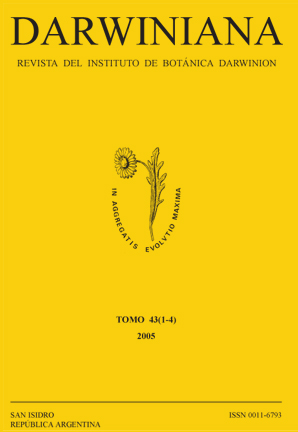NEW SPECIES OF WALTHERIA (HERMANNIEAE, BYTTNERIOIDEAE, MALVACEAE1 ) FROM PARAGUAY, ARGENTINA, AND VENEZUELA, AND TWO NEW RECORDS FOR PARAGUAY
DOI:
https://doi.org/10.14522/darwiniana.2014.431-4.140Keywords:
Waltheria, Hermannieae, Byttnerioideae, Malvaceae s.l., Argentina, Paraguay, Venezuela, Pollen morphologyAbstract
Waltheria carmensarae, a homostylous species from northeastern Argentina, southeastern Paraguay, and central Venezuela, and W. procumbens, a distylous species from northeastern Paraguay, are newly described and illustrated. Both species share along with some other species of Waltheria sect. Waltheria and all of sect. Stegowaltheria an elongate-plumose stigma, adaxial petals with raised succulent midribs, petals adnate to the stamen tube for more than 0.8 mm in length, and a capsule with hardened endocarp only at the apex. Waltheria carmensarae resembles the distylous species W. preslii, endemic to coastal Guerrero and Oaxaca, Mexico, whereas W. procumbens appears to be close to W.albicans, primarily from Brazil where distylous, with scattered homostylous and distylous distributions in Paraguay, Venezuela, and Mexico, or exclusively homostylous in Argentina. Pollen morphology is first described for W. carmensarae and Kohler’s description for W. prostrata is repeated for the new species W. procumbens. A regional key is included for all Argentinian and all Paraguayan species of
Waltheria. Waltheria operculata (sect. Stegowaltheria) is newly reported for Paraguay and W. albicans (sect. Waltheria) first appears with specimens cited for Paraguay.
Downloads
Published
31-12-2005
How to Cite
Saunders, J. G. (2005). NEW SPECIES OF WALTHERIA (HERMANNIEAE, BYTTNERIOIDEAE, MALVACEAE1 ) FROM PARAGUAY, ARGENTINA, AND VENEZUELA, AND TWO NEW RECORDS FOR PARAGUAY. Darwiniana, Nueva Serie, 43(1-4), 201–211. https://doi.org/10.14522/darwiniana.2014.431-4.140
Issue
Section
Systematics and Taxonomy of Plants
License

Starting on 2012, Darwiniana Nueva Serie uses Licencia Creative Commons Atribución-NoComercial 2.5 Argentina .






